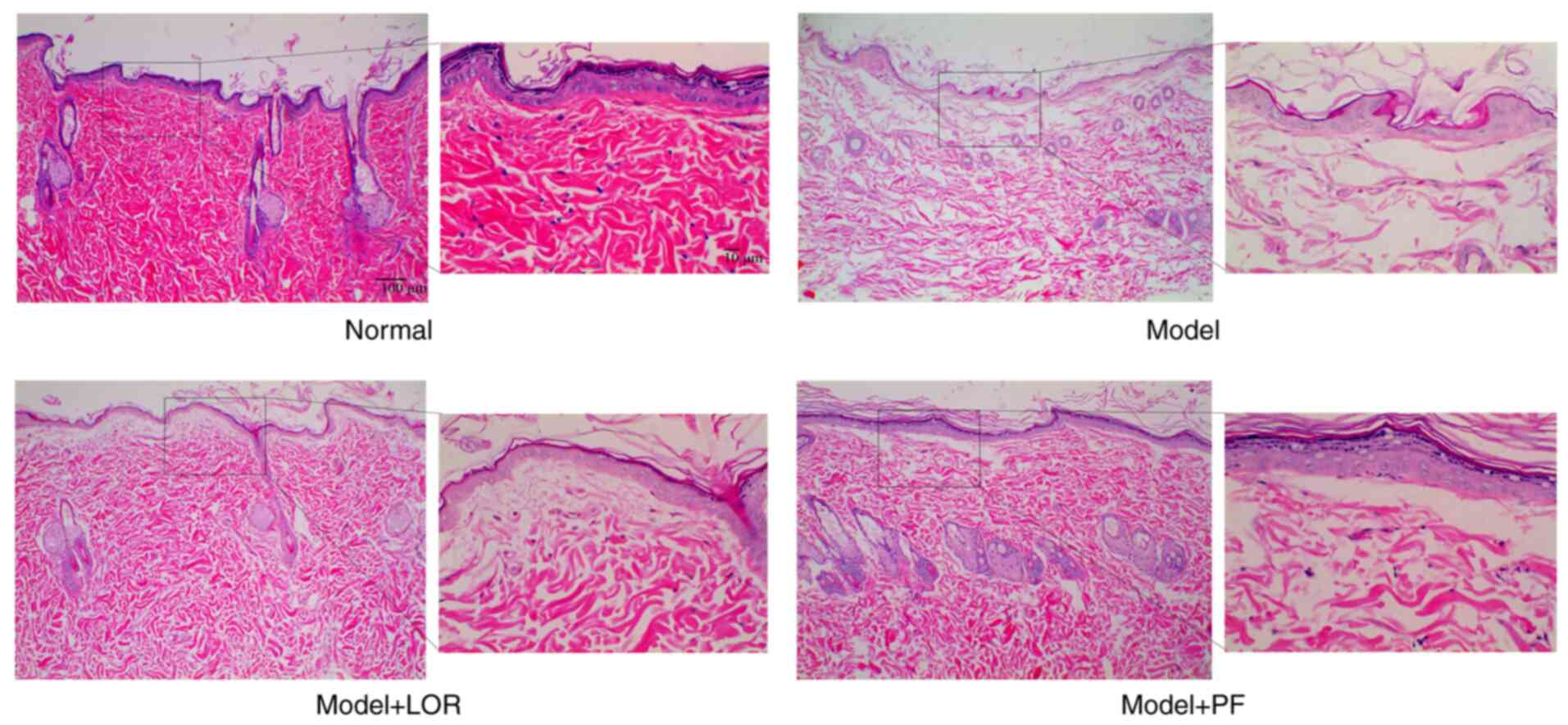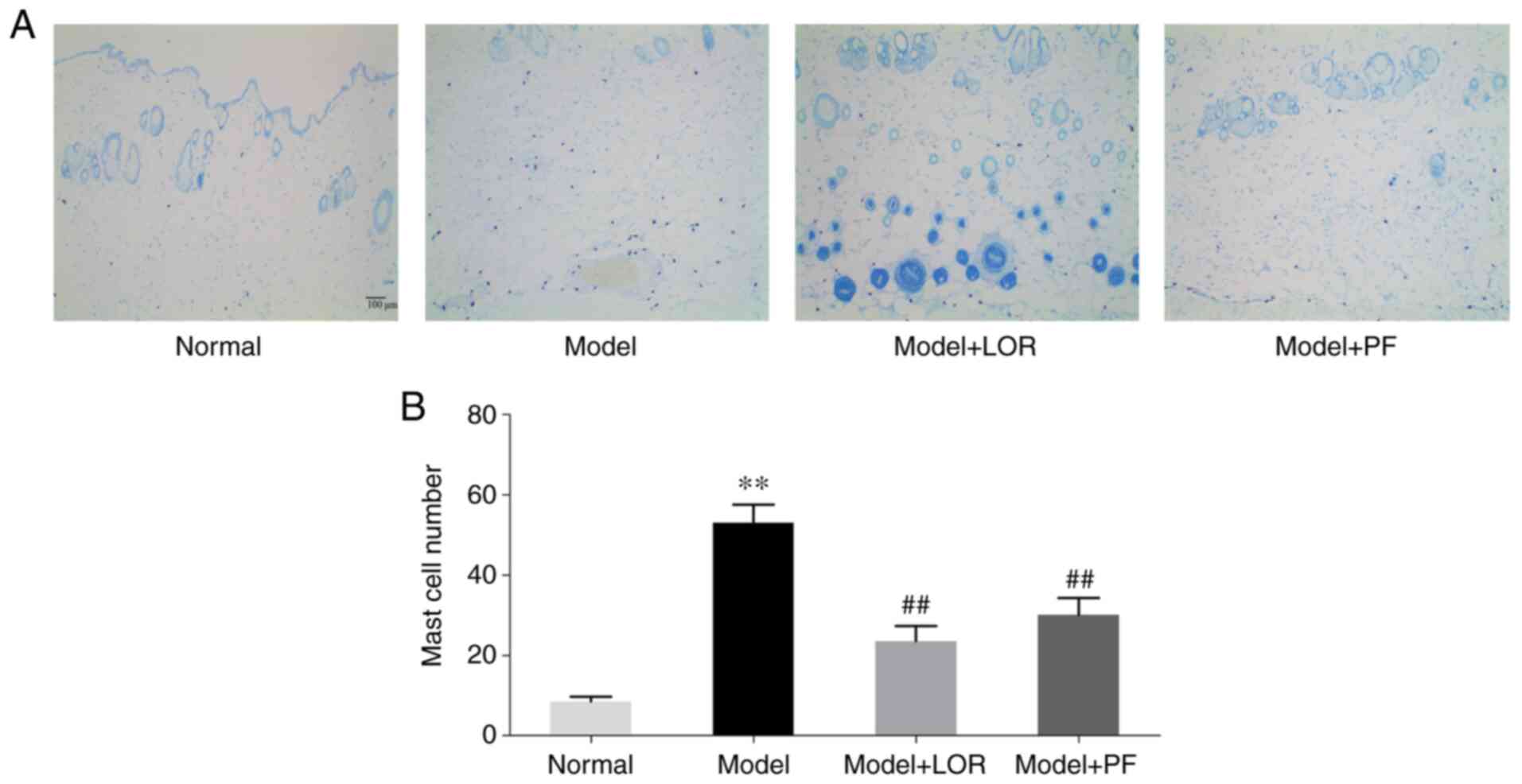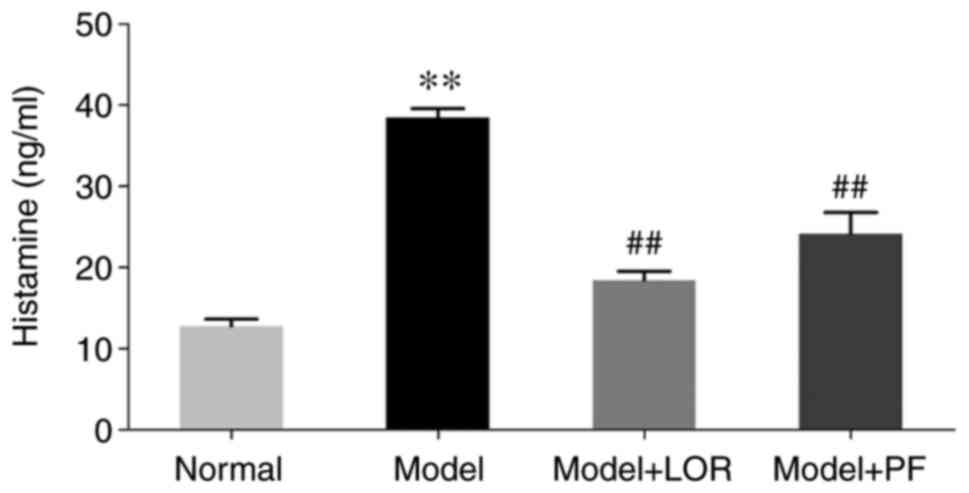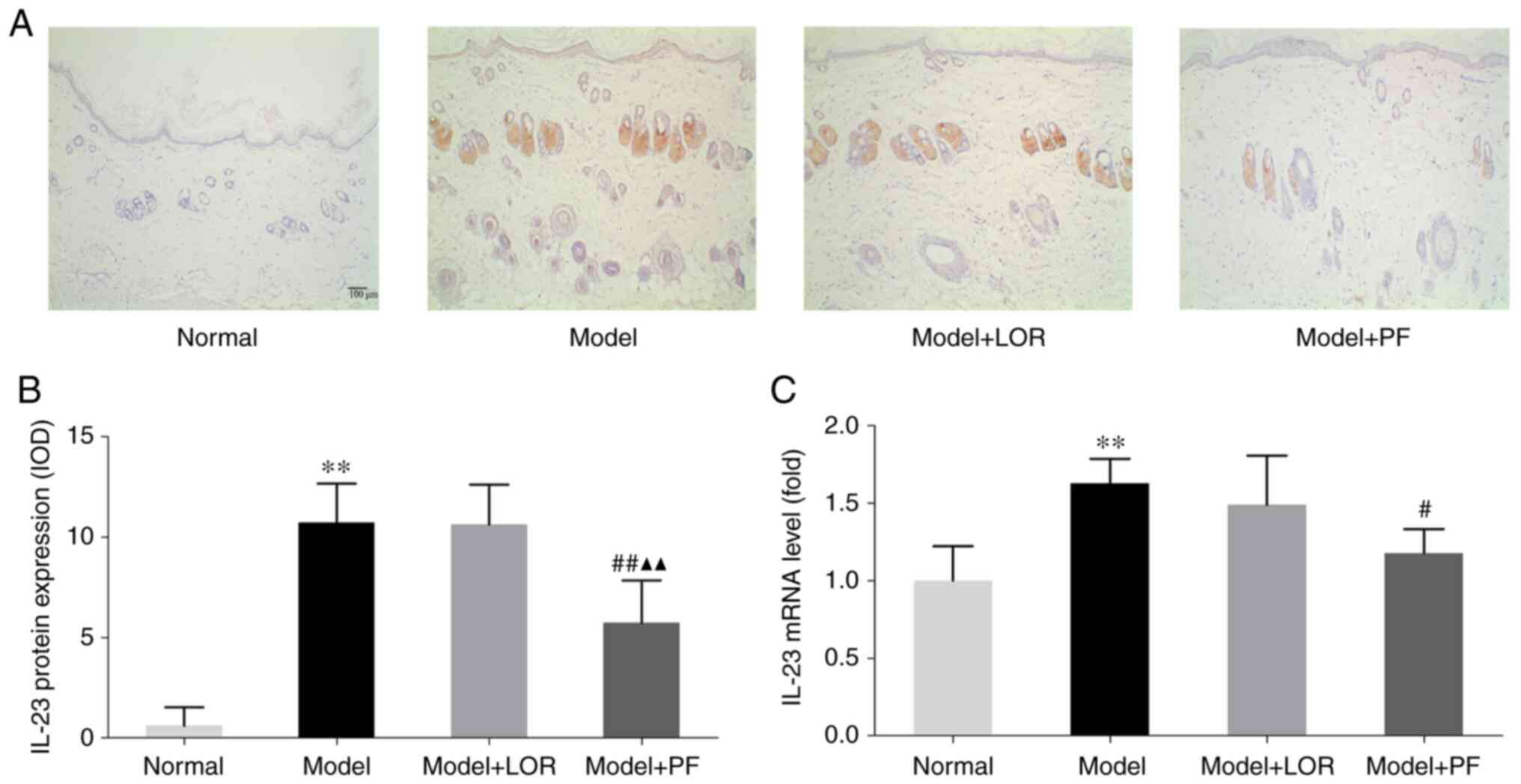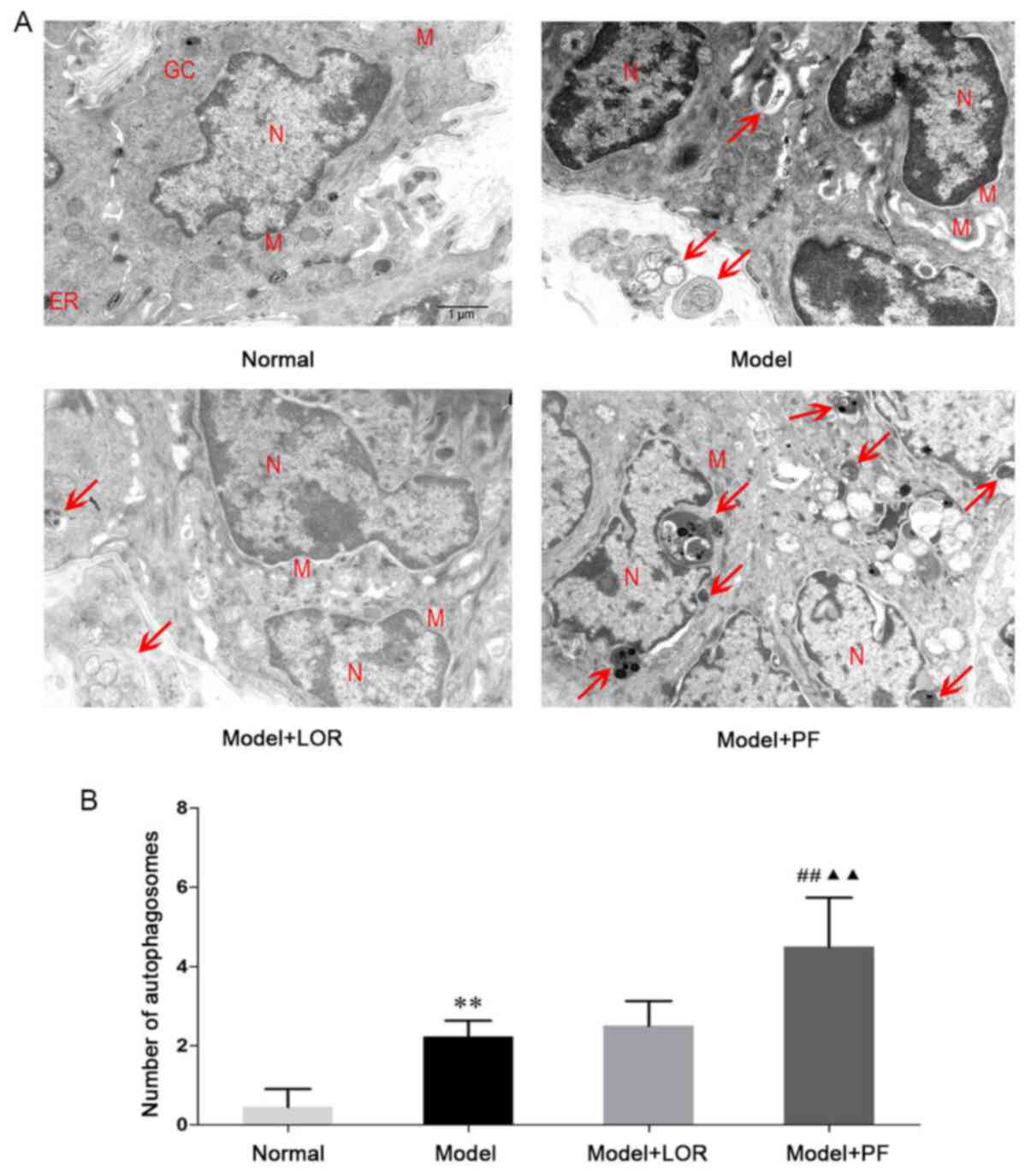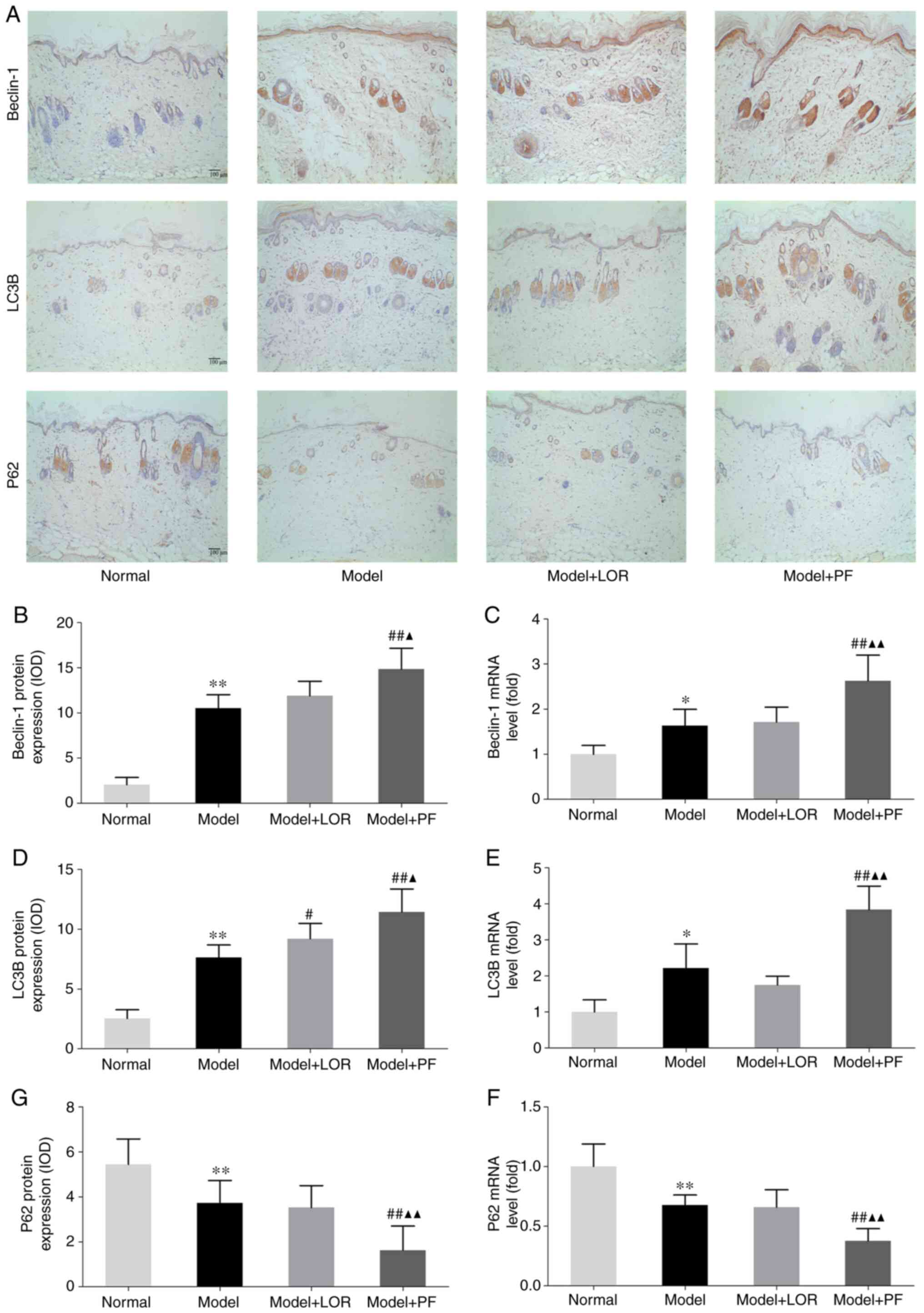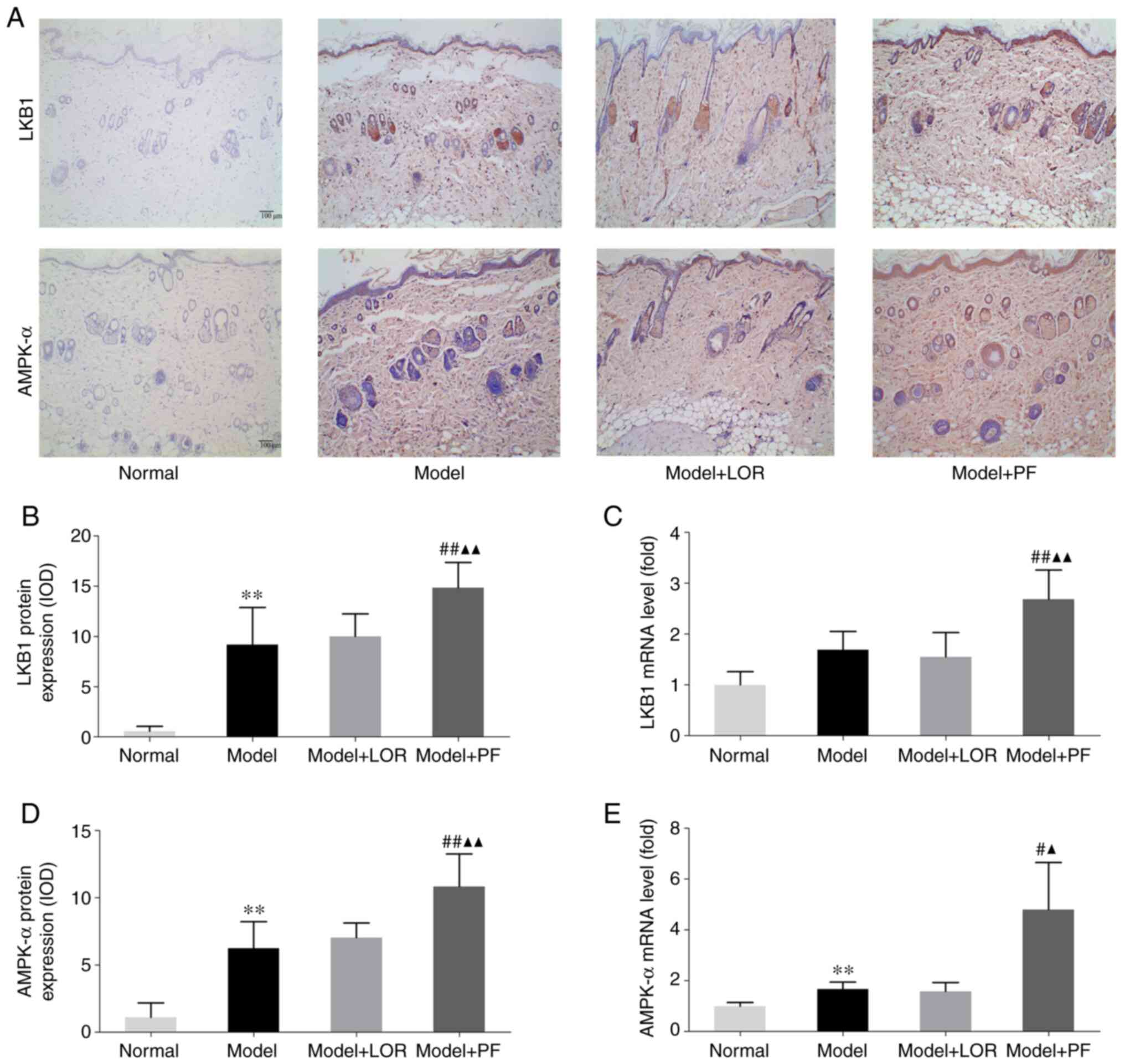|
1
|
Saini SS: Chronic spontaneous urticaria:
Etiology and pathogenesis. Immunol Allergy Clin North Am. 34:33–52.
2014.PubMed/NCBI View Article : Google Scholar
|
|
2
|
Maurer M, Staubach P, Raap U, Richter-Huhn
G, Bauer A, Ruëff F, Jakob T, Yazdi AS, Mahler V, Wagner N, et al:
H1-antihistamine-refractory chronic spontaneous urticaria: It's
worse than we thought - first results of the multicenter real-life
AWARE study. Clin Exp Allergy. 47:684–692. 2017.PubMed/NCBI View Article : Google Scholar
|
|
3
|
Zheng Q, Jiang W, Sun X, Ma T, Xu W, Shen
F, Li H, Xie S, Li B and Li X: Total glucosides of paeony for the
treatment of psoriasis: A systematic review and meta-analysis of
randomized controlled trials. Phytomedicine.
62(152940)2019.PubMed/NCBI View Article : Google Scholar
|
|
4
|
Li X, Shi F, Zhang R, Sun C, Gong C, Jian
L and Ding L: Pharmacokinetics, safety, and tolerability of
amygdalin and paeoniflorin after single and multiple intravenous
infusions of huoxue-tongluo lyophilized powder for injection in
healthy chinese volunteers. Clin Ther. 38:327–337. 2016.PubMed/NCBI View Article : Google Scholar
|
|
5
|
Lee S, Lim JM, Jin MH, Park HK, Lee EJ,
Kang S, Kim YS and Cho WG: Partially purified paeoniflorin exerts
protective effects on UV-induced DNA damage and reduces facial
wrinkles in human skin. J Cosmet Sci. 57:57–64. 2006.PubMed/NCBI
|
|
6
|
Wang C, Yuan J, Wu HX, Chang Y, Wang QT,
Wu YJ, Liu LH and Wei W: Paeoniflorin inhibits inflammatory
responses in mice with allergic contact dermatitis by regulating
the balance between inflammatory and anti-inflammatory cytokines.
Inflamm Res. 62:1035–1044. 2013.PubMed/NCBI View Article : Google Scholar
|
|
7
|
Sun Y, Zhang J, Huo R, Zhai T, Li H, Wu P,
Zhu X, Zhou Z, Shen B and Li N: Paeoniflorin inhibits skin lesions
in imiquimod-induced psoriasis-like mice by downregulating
inflammation. Int Immunopharmacol. 24:392–399. 2015.PubMed/NCBI View Article : Google Scholar
|
|
8
|
Chen T, Fu LX, Zhang LW, Yin B, Zhou PM,
Cao N and Lu YH: Paeoniflorin suppresses inflammatory response in
imiquimod-induced psoriasis-like mice and peripheral blood
mononuclear cells (PBMCs) from psoriasis patients. Can J Physiol
Pharmacol. 94:888–894. 2016.PubMed/NCBI View Article : Google Scholar
|
|
9
|
Choi EM, Suh KS, Rhee SY and Kim YS:
Inhibitory effect of paeoniflorin on methylglyoxal-mediated
oxidative stress in osteoblastic MC3T3-E1 cells. Phytomedicine.
21:1170–1177. 2014.PubMed/NCBI View Article : Google Scholar
|
|
10
|
Wang D, Wong HK, Feng YB and Zhang ZJ:
Paeoniflorin, a natural neuroprotective agent, modulates multiple
anti-apoptotic and pro-apoptotic pathways in differentiated PC12
cells. Cell Mol Neurobiol. 33:521–529. 2013.PubMed/NCBI View Article : Google Scholar
|
|
11
|
Zhang T, Yang Z, Yang S, Du J and Wang S:
Immunoregulatory effects of paeoniflorin exerts anti-asthmatic
effects via modulation of the Th1/Th2 equilibrium. Inflammation.
38:2017–2025. 2015.PubMed/NCBI View Article : Google Scholar
|
|
12
|
Levine B and Kroemer G: Autophagy in the
pathogenesis of disease. Cell. 132:27–42. 2008.PubMed/NCBI View Article : Google Scholar
|
|
13
|
Levine B, Mizushima N and Virgin HW:
Autophagy in immunity and inflammation. Nature. 469:323–335.
2011.PubMed/NCBI View Article : Google Scholar
|
|
14
|
Orosz L, Papanicolaou EG, Seprenyi G and
Megyeri K: IL-17A and IL-17F induce autophagy in RAW 264.7
macrophages. Biomed Pharmacother. 77:129–134. 2016.PubMed/NCBI View Article : Google Scholar
|
|
15
|
Racanelli AC, Kikkers SA, Choi AMK and
Cloonan SM: Autophagy and inflammation in chronic respiratory
disease. Autophagy. 14:221–232. 2018.PubMed/NCBI View Article : Google Scholar
|
|
16
|
Mathur R, Alam MM, Zhao XF, Liao Y, Shen
J, Morgan S, Huang T, Lee H, Lee E and Huang Y and Huang Y:
Induction of autophagy in Cx3cr1+ mononuclear cells
limits IL-23/IL-22 axis-mediated intestinal fibrosis. Mucosal
Immunol. 12:612–623. 2019.PubMed/NCBI View Article : Google Scholar
|
|
17
|
Peral de Castro C, Jones SA, Ni Cheallaigh
C, Hearnden CA, Williams L, Winter J, Lavelle EC, Mills KH and
Harris J: Autophagy regulates IL-23 secretion and innate T cell
responses through effects on IL-1 secretion. J immunol.
189:4144–4153. 2012.PubMed/NCBI View Article : Google Scholar
|
|
18
|
Kwon SH, Lim CJ, Jung J, Kim HJ, Park K,
Shin JW, Huh CH, Park KC and Na JI: The effect autophagy-enhancing
peptide in moisturizer on atopic dermatitis: A randomized
controlled trial. J Dermatolog Treat. 30:558–564. 2019.PubMed/NCBI View Article : Google Scholar
|
|
19
|
Livak KJ and Schmittgen TD: Analysis of
relative gene expression data using real-time quantitative PCR and
the 2(-Delta Delta C(T)) method. Methods. 25:402–408.
2001.PubMed/NCBI View Article : Google Scholar
|
|
20
|
Ying S, Kikuchi Y, Meng Q, Kay AB and
Kaplan AP: TH1/TH2 cytokines and inflammatory cells in skin biopsy
specimens from patients with chronic idiopathic urticaria:
Comparison with the allergen-induced late-phase cutaneous reaction.
J Allergy Clin Immunol. 109:694–700. 2002.PubMed/NCBI View Article : Google Scholar
|
|
21
|
Sun B, Wang B and Xu M: Esculetin inhibits
histamine-induced expression of inflammatory cytokines and mucin in
nasal epithelial cells. Clin Exp Pharmacol Physiol. 46:821–827.
2019.PubMed/NCBI View Article : Google Scholar
|
|
22
|
Metz M and Maurer M: Mast cells-key
effector cells in immune responses. Trends Immunol. 28:234–241.
2007.PubMed/NCBI View Article : Google Scholar
|
|
23
|
Hawkes JE, Yan BY, Chan TC and Krueger JG:
Discovery of the IL-23/IL-17 signaling pathway and the treatment of
psoriasis. J Immunol. 201:1605–1613. 2018.PubMed/NCBI View Article : Google Scholar
|
|
24
|
Mizutani N, Sae-Wong C, Kangsanant S, Nabe
T and Yoshino S: Thymic stromal lymphopoietin-induced
interleukin-17A is involved in the development of IgE-mediated
atopic dermatitis-like skin lesions in mice. Immunology.
146:568–581. 2015.PubMed/NCBI View Article : Google Scholar
|
|
25
|
Larsen JM, Bonefeld CM, Poulsen SS,
Geisler C and Skov L: IL-23 and T(H)17-mediated inflammation in
human allergic contact dermatitis. J Allergy Clin Immunol.
123:486–492. 2009.PubMed/NCBI View Article : Google Scholar
|
|
26
|
Kihara A, Kabeya Y, Ohsumi Y and Yoshimori
T: Beclin-phosphatidylinositol 3-kinase complex functions at the
trans-Golgi network. EMBO Rep. 2:330–335. 2001.PubMed/NCBI View Article : Google Scholar
|
|
27
|
Kabeya Y, Mizushima N, Ueno T, Yamamoto A,
Kirisako T, Noda T, Kominami E, Ohsumi Y and Yoshimori T: LC3, a
mammalian homologue of yeast Apg8p, is localized in autophagosome
membranes after processing. EMBO J. 19:5720–5728. 2000.PubMed/NCBI View Article : Google Scholar
|
|
28
|
Jin P, Jiang J, Xie N, Zhou L, Huang Z,
Zhang L, Qin S, Fu S, Peng L, Gao W, et al: MCT1 relieves
osimertinib-induced CRC suppression by promoting autophagy through
the LKB1/AMPK signaling. Cell Death Dis. 10(615)2019.PubMed/NCBI View Article : Google Scholar
|
|
29
|
Zhang M, Deng YN, Zhang JY, Liu J, Li YB,
Su H and Qu QM: SIRT3 Protects rotenone-induced Injury in SH-SY5Y
cells by promoting autophagy through the LKB1-AMPK-mTOR pathway.
Aging Dis. 9:273–286. 2018.PubMed/NCBI View Article : Google Scholar
|
|
30
|
Schön MP and Erpenbeck L: The
interleukin-23/Interleukin-17 axis links adaptive and innate
immunity in psoriasis. Front Immunol. 9(1323)2018.PubMed/NCBI View Article : Google Scholar
|
|
31
|
Langrish CL, Chen Y, Blumenschein WM,
Mattson J, Basham B, Sedgwick JD, McClanahan T, Kastelein RA and
Cua DJ: IL-23 drives a pathogenic T cell population that induces
autoimmune inflammation. J Exp Me. 201:233–240. 2005.PubMed/NCBI View Article : Google Scholar
|
|
32
|
Li H, Yao Q, Mariscal AG, Wu X, Hülse J,
Pedersen E, Helin K, Waisman A, Vinkel C, Thomsen SF, et al:
Epigenetic control of IL-23 expression in keratinocytes is
important for chronic skin inflammation. Nat Commun.
9(1420)2018.PubMed/NCBI View Article : Google Scholar
|
|
33
|
Lee J, Rodero MP, Patel J, Moi D, Mazzieri
R and Khosrotehrani K: Interleukin-23 regulates interleukin-17
expression in wounds, and its inhibition accelerates diabetic wound
healing through the alteration of macrophage polarization. FASEB J.
32:2086–2094. 2018.PubMed/NCBI View Article : Google Scholar
|
|
34
|
Kopp T, Riedl E, Bangert C, Bowman EP,
Greisenegger E, Horowitz A, Kittler H, Blumenschein WM, McClanahan
TK, Marbury T, et al: Clinical improvement in psoriasis with
specific targeting of interleukin-23. Nature. 521:222–226.
2015.PubMed/NCBI View Article : Google Scholar
|
|
35
|
Terui T, Kobayashi S, Okubo Y, Murakami M,
Hirose K and Kubo H: Efficacy and safety of guselkumab, an
anti-interleukin 23 monoclonal antibody, for palmoplantar
pustulosis: A randomized clinical trial. JAMA Dermatol.
154:309–316. 2018.PubMed/NCBI View Article : Google Scholar
|
|
36
|
Feldmeyer L, Mylonas A, Demaria O,
Mennella A, Yawalkar N, Laffitte E, Hohl D, Gilliet M and Conrad C:
Interleukin 23-helper T cell 17 axis as a treatment target for
pityriasis rubra pilaris. JAMA Dermatol. 153:304–308.
2017.PubMed/NCBI View Article : Google Scholar
|
|
37
|
Rai S, Arasteh M, Jefferson M, Pearson T,
Wang Y, Zhang W, Bicsak B, Divekar D, Powell PP, Naumann P, et al:
The ATG5-binding and coiled coil domains of ATG16L1 maintain
autophagy and tissue homeostasis in mice independently of the WD
domain required for LC3-associated phagocytosis. Autophagy.
15:599–612. 2019.PubMed/NCBI View Article : Google Scholar
|
|
38
|
Cecconi F and Levine B: The role of
autophagy in mammalian development: Cell makeover rather than cell
death. Dev Cell. 15:344–357. 2008.PubMed/NCBI View Article : Google Scholar
|
|
39
|
Bjørkøy G, Lamark T, Brech A, Outzen H,
Perander M, Overvatn A, Stenmark H and Johansen T: p62/SQSTM1 forms
protein aggregates degraded by autophagy and has a protective
effect on huntingtin-induced cell death. J Cell Biol. 171:603–614.
2005.PubMed/NCBI View Article : Google Scholar
|
|
40
|
Pankiv S, Clausen TH, Lamark T, Brech A,
Bruun JA, Outzen H, Øvervatn A, Bjørkøy G and Johansen T:
p62/SQSTM1 binds directly to Atg8/LC3 to facilitate degradation of
ubiquitinated protein aggregates by autophagy. J Biol Chem.
282:24131–24145. 2007.PubMed/NCBI View Article : Google Scholar
|
|
41
|
Zimmermann K, Baldinger J, Mayerhofer B,
Atanasov AG and Dirsch VM: Activated AMPK boosts the Nrf2/HO-1
signaling axis-A role for the unfolded protein response. Free Radic
Biol Med. 88:417–426. 2015.PubMed/NCBI View Article : Google Scholar
|
|
42
|
Wen J, Xu B, Sun Y, Lian M, Li Y, Lin Y,
Chen D and Diao Y: Paeoniflorin protects against intestinal
ischemia/reperfusion by activating LKB1/AMPK and promoting
autophagy. Pharmacol Res. 146(104308)2019.PubMed/NCBI View Article : Google Scholar
|
|
43
|
Li YC, Qiao JY, Wang BY, Bai M, Shen JD
and Cheng YX: Paeoniflorin ameliorates fructose-induced insulin
resistance and hepatic steatosis by activating LKB1/AMPK and AKT
pathways. Nutrients. 10(1024)2018.PubMed/NCBI View Article : Google Scholar
|















